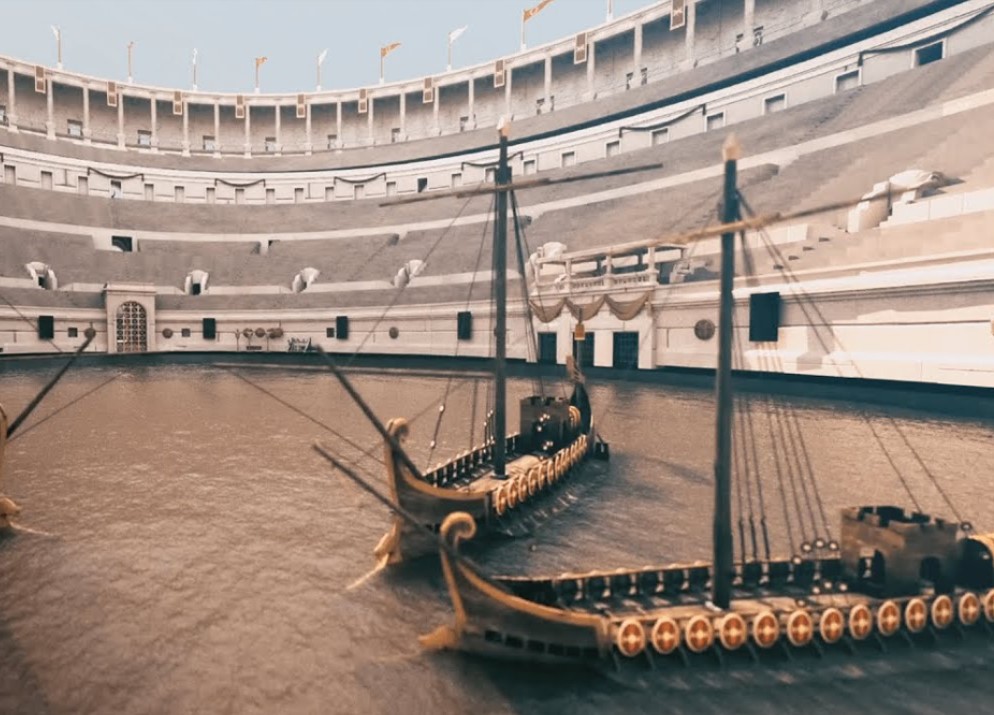The Colosseum is widely recognized for its gladiatorial contests, but few are aware that the Romans also staged mock naval battles within its walls. This remarkable feat involved flooding the Colosseum to create a temporary arena for these epic spectacles. In this article, we explore how the Romans managed this engineering marvel and the reasons behind it.
The Origins of Colosseum Naval Battles
The tradition of staging naval battles, known as naumachiae, began in 46 B.C. when Julius Caesar celebrated his victory over Pompey the Great. To commemorate his military triumphs in Gaul and Egypt, Caesar ordered the excavation of a large basin near the Tiber River. This artificial lake, surrounded by marble seating, hosted a grand sea battle featuring 12 Roman galleys and up to 3,000 men. The event drew spectators from across Italy and set the stage for future Roman spectacles.
When the Colosseum was completed, the Romans saw it as the perfect venue to continue this tradition. During the arena’s inaugural games, Emperor Titus ordered the Colosseum to be flooded for a mock naval battle, replicating a historical conflict between Athens and Syracuse. The event even included an artificial island where combatants disembarked to fight on land.
Engineering the Flooding of the Colosseum
Flooding the Colosseum for these naval battles was no small feat. The Romans employed a sophisticated system, likely involving aqueducts and drainage channels, to quickly fill and drain the arena. Special flat-bottomed ships were used due to the shallow depth of the water, allowing the battle to unfold as spectators watched from above.
Historians debate the exact methods used to flood the Colosseum, especially given the arena’s later modifications, such as the construction of the hypogeum—a network of tunnels and chambers beneath the arena floor. After the hypogeum was built during Emperor Domitian’s reign, naval battles in the Colosseum became impossible due to the structural changes that made flooding the arena impractical.
A similar arena in Verona provides some clues about how the flooding might have worked. The Veronese amphitheater featured a basin connected to two conduits—one for filling the basin with water and another for draining it into the Adige River. This system could have inspired the techniques used in the Colosseum.
The Decline of Colosseum Naval Battles
Arena-based naumachiae became a popular, yet costly, form of entertainment in ancient Rome. However, their grandeur eventually waned, and Roman audiences lost interest. Gladiatorial combats and other violent spectacles captured more public attention. Moreover, the empire’s financial difficulties in the third century likely contributed to the decline of these elaborate events.
The final recorded naval battle in the Colosseum took place in A.D. 89 under Emperor Domitian. The expense and logistical challenges of staging these battles, coupled with the empire’s weakening economy, led to their eventual discontinuation.
The naval battles in the Colosseum are a testament to the Romans’ ingenuity and their insatiable appetite for entertainment. While the exact details of how these events were executed remain a topic of debate among historians, the fact that they occurred at all highlights the extraordinary capabilities of Roman engineering. As one of the most ambitious spectacles in ancient history, these naval battles add another layer to our understanding of the Colosseum’s rich and complex legacy.
I am the Librarian, and I, together with the guardians of the Ancient Library, curate content for this site. Welcome, and enjoy your stay.





